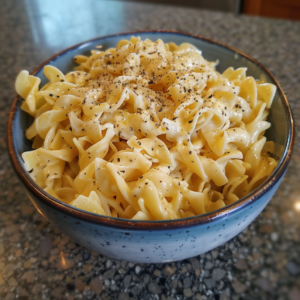Introduction:
Haluski is a beloved comfort food that hails from Eastern Europe, particularly popular in countries like Poland, Slovakia, and Ukraine. This simple yet satisfying dish features tender cabbage, caramelized onions, and hearty egg noodles, all cooked together to create a flavorful and comforting meal. In this article, we’ll delve into the rich history of Haluski, its cultural significance, and how to prepare this timeless classic in your own kitchen.
Ingredients:
- 8 ounces uncooked egg noodles Amish egg noodles are perfect for this
- 6 tablespoons butter unsalted
- 1 large onion chopped
- 2 cloves garlic minced
- 1 1/2 -2 pounds green cabbage cut in bite sized pices
- salt and pepper to taste
Instructions:

- Boil the egg noodles in a large pot of salted water according to package directions and drain well.
- Meanwhile, melt the butter in a large skillet over medium heat. Add onion to the skillet until the onions are soft Reduce the heat to low and add the garlic, cooking for about 30 seconds while stirring continuously. Add the cabbage and continue cooking and stirring until the cabbage is tender.
- Add the cooked egg noodles to the cabbage mixture and toss to coat.
- Season with kosher salt and plenty of fresh ground black pepper.
Serving Tips:
- Garnish for Presentation: Before serving Haluski, consider garnishing it with a sprinkle of fresh herbs such as parsley or dill. This adds a pop of color and freshness to the dish, enhancing its visual appeal.
- Serve as a Main or Side: Haluski can be served as a standalone main dish or as a hearty side alongside grilled meats, sausages, or roasted poultry. Its versatility makes it suitable for any mealtime.
- Accompaniments: Pair Haluski with traditional Eastern European condiments such as sour cream or apple sauce. These additions provide a creamy or tangy contrast to the savory flavors of the dish.
- Family-Style Presentation: Consider serving Haluski family-style in a large serving dish or platter, allowing guests to help themselves. This fosters a communal dining experience and encourages sharing and camaraderie.
Storage Tips:
- Refrigerate Promptly: If you have leftovers, store Haluski in an airtight container in the refrigerator promptly after serving. This helps maintain its freshness and prevents spoilage.
- Consume Within 3-4 Days: Haluski can typically be refrigerated for 3-4 days. Beyond this timeframe, the quality may begin to deteriorate, and the flavors may become less vibrant.
- Reheat with Care: When reheating leftovers, do so gently to prevent the noodles from becoming mushy or overcooked. Use a microwave on low power or reheat in a skillet over low heat, adding a splash of water or broth to maintain moisture.
- Avoid Freezing: Due to the nature of the ingredients, Haluski may not freeze well. Freezing can cause the texture to become mushy and affect the overall quality of the dish. It’s best enjoyed fresh or refrigerated for short-term storage.

